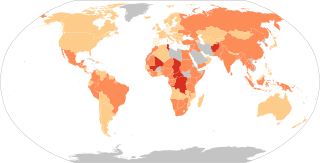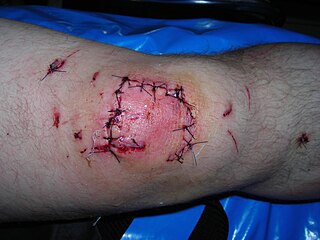Related Research Articles
Civil procedure is the body of law that sets out the rules and standards that courts follow when adjudicating civil lawsuits. These rules govern how a lawsuit or case may be commenced; what kind of service of process is required; the types of pleadings or statements of case, motions or applications, and orders allowed in civil cases; the timing and manner of depositions and discovery or disclosure; the conduct of trials; the process for judgment; the process for post-trial procedures; various available remedies; and how the courts and clerks must function.
At common law, battery is a tort falling under the umbrella term 'Trespass to the person'. Entailing unlawful contact which is directed and intentional, or reckless and voluntarily bringing about a harmful or offensive contact with a person or to something closely associated with them, such as a bag or purse, without legal consent.
Character evidence is a term used in the law of evidence to describe any testimony or document submitted for the purpose of proving that a person acted in a particular way on a particular occasion based on the character or disposition of that person. In the United States, Federal Rule of Evidence 404 maps out its permissible and prohibited uses in trials. Three factors typically determine the admissibility of character evidence:
- the purpose for which the character evidence is being used
- the form in which the character evidence is offered
- the type of proceeding in which the character evidence is offered

Bolam v Friern Hospital Management Committee [1957] 1 WLR 582 is an English tort law case that lays down the typical rule for assessing the appropriate standard of reasonable care in negligence cases involving skilled professionals such as doctors. This rule is known as the Bolam test, and states that if a doctor reaches the standard of a responsible body of medical opinion, they are not negligent. Bolam was rejected in the 2015 Supreme Court decision of Montgomery v Lanarkshire Health Board in matters of informed consent.
Causation is the "causal relationship between the defendant's conduct and end result". In other words, causation provides a means of connecting conduct with a resulting effect, typically an injury. In criminal law, it is defined as the actus reus from which the specific injury or other effect arose and is combined with mens rea to comprise the elements of guilt. Causation only applies where a result has been achieved and therefore is immaterial with regard to inchoate offenses.
In law, an omission is a failure to act, which generally attracts different legal consequences from positive conduct. In the criminal law, an omission will constitute an actus reus and give rise to liability only when the law imposes a duty to act and the defendant is in breach of that duty. In tort law, similarly, liability will be imposed for an omission only exceptionally, when it can be established that the defendant was under a duty to act or duty of care.
Manslaughter is a common law legal term for homicide considered by law as less culpable than murder. The distinction between murder and manslaughter is sometimes said to have first been made by the ancient Athenian lawmaker Draco in the 7th century BC.

Rape is a type of sexual assault involving sexual intercourse or other forms of sexual penetration carried out against a person without their consent. The act may be carried out by physical force, coercion, abuse of authority, or against a person who is incapable of giving valid consent, such as one who is unconscious, incapacitated, has an intellectual disability, or is below the legal age of consent. The term rape is sometimes used interchangeably with the term sexual assault.

R v Holland (1841) is a general-principle English criminal law decision as to novus actus interveniens — breaking the chain of causation. It confirmed the rarity of scenarios that will break the chain when serious, intentional bodily harm is carried out.

R v Cheshire [1991] 1 WLR 844 is an English criminal law case establishing the role of the jury in finding liability for death, where subsequent medical negligence occurs following the original injury. The Court of Appeal found that the jury did not have to weigh up different causes of death, and need only be satisfied that the defendant's actions made a "significant contribution" to the victim's death.

Nazi human experimentation was a series of medical experiments on prisoners by Nazi Germany in its concentration camps mainly between 1942 and 1945. There were at least 15,754 documented victims from a variety of nationalities and age groups, although the plurality were young adults at the time of the experiment. Although most victims survived, many suffered disability as a result.
Criminal law is the body of law that relates to crime. It prescribes conduct perceived as threatening, harmful, or otherwise endangering to the property, health, safety, and welfare of people inclusive of one's self. Most criminal law is established by statute, which is to say that the laws are enacted by a legislature. Criminal law includes the punishment and rehabilitation of people who violate such laws.

The Geneva Conventions are four treaties, and three additional protocols, that establish international legal standards for humanitarian treatment in war. The singular term Geneva Convention usually denotes the agreements of 1949, negotiated in the aftermath of the Second World War (1939–1945), which updated the terms of the two 1929 treaties and added two new conventions. The Geneva Conventions extensively define the basic rights of wartime prisoners, civilians and military personnel, established protections for the wounded and sick, and provided protections for the civilians in and around a war-zone.

Landeros v. Flood was a 1976 court case in the state of California involving child abuse and alleged medical malpractice.

R v Jordan (1956) 40 Cr App R 152 was an English criminal law case that has been distinguished by two later key cases of equal precedent rank for its ruling that some situations of medical negligence following a wounding are those of breaking the chain of causation, capable of absolving a person who has inflicted bodily harm of guilt for an offence of the severity resulting from a consequent decline in bodily condition, in particular, homicide. The facts were ones whereby a wound was should to be almost certain, with no treatment, to heal itself. The medical attempt to facilitate recovery from the wound resulted in a non-prosecutable death as it was shown to have been negligent and principally an antibiotic error though far from unknown and well-intentioned. The appropriate charge(s) would be ones relating to wounding or disorder of the defendant, rather than homicide which could not have been said to have been caused by the defendant in any meaningful way.

The eggshell rule is a well-established legal doctrine in common law, used in some tort law systems, with a similar doctrine applicable to criminal law. The rule states that, in a tort case, the unexpected frailty of the injured person is not a valid defense to the seriousness of any injury caused to them.
South African criminal law is the body of national law relating to crime in South Africa. In the definition of Van der Walt et al., a crime is "conduct which common or statute law prohibits and expressly or impliedly subjects to punishment remissible by the state alone and which the offender cannot avoid by his own act once he has been convicted." Crime involves the infliction of harm against society. The function or object of criminal law is to provide a social mechanism with which to coerce members of society to abstain from conduct that is harmful to the interests of society.
S v Mokgethi en Andere is an important case in South African law, with the court's determination that, in general, a perpetrator's action, which is a sine qua non for the death of the deceased, is too remote from the result to give rise to criminal liability if
- a failure on the part of the deceased to obtain medical or similar advice, to undergo treatment or to follow instructions as to his treatment is the immediate cause of his death;
- the wounding was not in itself lethal or was no longer lethal at the relevant time; and
- such failure was relatively unreasonable: that is, unreasonable also taking into account the characteristics, convictions, etc., of the deceased.
S v Tembani may refer to either of two important cases in South African criminal law:
Cruel, inhuman or degrading treatment (CIDT) is treatment of persons which is contrary to human rights or dignity, but is not classified as torture. It is forbidden by the Universal Declaration of Human Rights, Article 3 of the European Convention on Human Rights, the United Nations Convention against Torture and the International Covenant on Civil and Political Rights. Although the distinction between torture and CIDT is maintained from a legal point of view, medical and psychological studies have found that it does not exist from the psychological point of view, and people subjected to CIDT will experience the same consequences as survivors of torture. Based on this research, some practitioners have recommended abolishing the distinction.
References
- S v Tembani 2007 (1) SACR 355 (SCA).